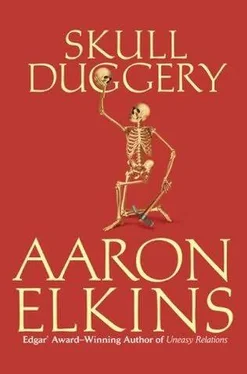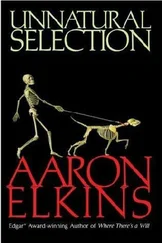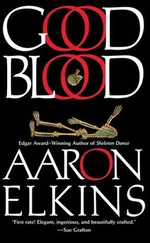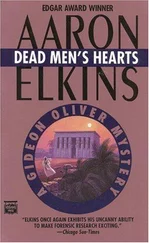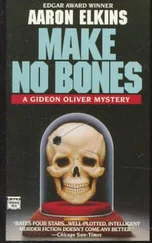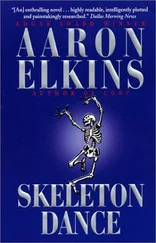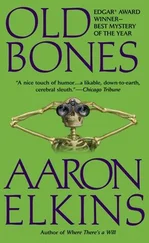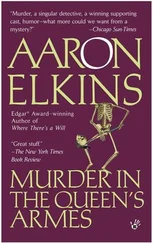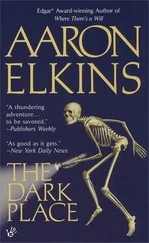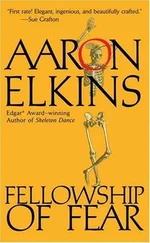Aaron Elkins - Skull Duggery
Здесь есть возможность читать онлайн «Aaron Elkins - Skull Duggery» весь текст электронной книги совершенно бесплатно (целиком полную версию без сокращений). В некоторых случаях можно слушать аудио, скачать через торрент в формате fb2 и присутствует краткое содержание. Жанр: Классический детектив, на английском языке. Описание произведения, (предисловие) а так же отзывы посетителей доступны на портале библиотеки ЛибКат.
- Название:Skull Duggery
- Автор:
- Жанр:
- Год:неизвестен
- ISBN:нет данных
- Рейтинг книги:4 / 5. Голосов: 1
-
Избранное:Добавить в избранное
- Отзывы:
-
Ваша оценка:
- 80
- 1
- 2
- 3
- 4
- 5
Skull Duggery: краткое содержание, описание и аннотация
Предлагаем к чтению аннотацию, описание, краткое содержание или предисловие (зависит от того, что написал сам автор книги «Skull Duggery»). Если вы не нашли необходимую информацию о книге — напишите в комментариях, мы постараемся отыскать её.
Skull Duggery — читать онлайн бесплатно полную книгу (весь текст) целиком
Ниже представлен текст книги, разбитый по страницам. Система сохранения места последней прочитанной страницы, позволяет с удобством читать онлайн бесплатно книгу «Skull Duggery», без необходимости каждый раз заново искать на чём Вы остановились. Поставьте закладку, и сможете в любой момент перейти на страницу, на которой закончили чтение.
Интервал:
Закладка:
“You’re right,” Gideon said. “They can’t.”
“So what’s the point?”
Julie finished the last of her coffee and put down the cup. “The point,” she said, “is that Gideon has never met a skeleton he didn’t want to know better.”
Tony laughed his gravel-on-a-tin-drum laugh. “Well, what the hell, chacun a son gout,” he said surprisingly: French for each to his own .
NINETEEN
Yagul.
Contrary to what he’d said to Tony, he wasn’t here simply because it was the closest site. He had been a twenty-year-old junior at UCLA when he’d first come across its name in a Mesoamerican prehistory survey course, and it had been one of the factors that had turned him into an anthropology major. “An intermittently occupied Mixtec-Zapotec site of limited archaeological significance,” his textbook had called it, “located in the eastern Valley of Oaxaca, a remote area of central southern Mexico, and thought to be concurrent with Mitla (of which it is sometimes considered an inferior imitation) and Monte Alban, more important settlements to the north. Its most notable feature is a ball court with fretted stone mosaics of a conventional style, believed to be second in size only to the far more impressive court at Chichen Itza.”
This decidedly lukewarm description notwithstanding, the deliciously exotic sound of it, Yah-goohl, had stirred his youthful and adventurous soul. It was the kind of word you might expect to hear from the first Venusian to visit Earth when he stepped from his flying saucer and held up a two-fingered, vaguely hand-like appendage in greeting: “Yah-goohl, Earthlings.”
A little something of its magic was lost when he learned that it was Zapotecan for dry stick, but it had remained a symbol of the strange, prehistoric, fascinating places that a career in anthropology might take him. I will stand among the ancient stones of Yah-goohl someday, he had told himself, and with such travels in mind he had started out in the sub-discipline of archaeology. But within a year it had been evolution, bones, and physical anthropology that had snared him for good, so that, until Julie had brought up the idea of coming to Oaxaca a few weeks ago, it had been more than two decades since the site had even crossed his mind.
And now here he was, taking it all in from a rise at the edge of the otherwise empty parking area at the end of a rough, two-mile-long dirt road, pretty much in the middle of nowhere, surrounded by scrubland and dry river beds; not a sign of modern humanity in sight, other than a ramshackle booth at the entrance with a hand-painted wooden sign: ENTRADA 10 PESOS. But no one was in the booth to collect the fees, and it looked as if no one had been in it for a long time. Obviously, Yagul didn’t get enough visitors to make it worthwhile. That was equally clear from the potsherds that littered the ground, just sitting there for the picking; you didn’t find those at Monte Alban or Teotihuacan.
He’d Googled the site earlier to refresh his memory and located plenty of material (what was there that didn’t have plenty of material on Google?), so he’d known what he would find, but still, it was bigger and more interesting than he’d expected. There were three main areas. In the center was the famous ball court, as well as the imaginatively named “Palace of the Six Patios,” originally probably civic/ religious offices, but now a roofless, moldering warren of stuccoed stone-and-clay walls and foundations. From this central area, stone steps led up a sizeable hill to the walled “fortress,” which probably had been a defensive compound. And in an area east of the ball court was a group of sunken tombs.
The best thing about it, he thought with selfish pleasure, was that he had it all to himself. No iron-lunged tour guides with yellow umbrellas, shouting commands at their obedient, beaten-down herds; no yelling kids scrambling over the stones and crying when they skinned their knees; nothing noisier than the sound of his shoes on the stony pathways, and an occasional whisper of breeze sighing through one of the runty trees that had sprouted here and there around the ruin. But it was still early, barely nine o’clock, so it was likely that other people would be showing up as the day wore on. He decided to hit the tombs first, before that happened. They were a labyrinth of semi-subterranean chambers that were bound to be small and cramped, best seen without company.
They were as dank and stuffy and constricted as he’d imagined, but every bit as interesting too, made all the more atmospheric by the sparse shafts of daylight, filled with slowly swirling dust motes, that provided all the illumination there was. He spent a blissful half hour prowling from chamber to chamber-mostly on his knees; the openings were only about three feet high-examining and touching the geometric stone mosaics and the strange, Olmec-style heads carved in bas-relief on the walls, and in general happily communing with the spirits of people long, long gone.
When he crawled blinking into the sunlight, he practically bumped into a pair of hairy, bowling-ball-calved legs topped by green walking shorts.
“Hey, here you are!” came from two feet above the shorts. “I was looking for you.”
“Tony!” Gideon got to his feet. “I thought you couldn’t make it.”
“I figured, what the hell, the wiring waited this long,” Tony said. “And Preciosa isn’t gonna be conscious until eleven anyway, and if she has to get breakfast herself, no big deal, she can handle it. So what’s in there, the tombs?”
“Yes, want to have a look?”
“Do I have to crawl around on my hands and knees like you were?”
“Afraid so.”
“I’ll give it a skip, then. What else is there to see? What’s this ball court you were talking about?”
“I was just going to head for it. It’s right over there.”
“Okay if I go with you? Maybe I’ll learn something.”
“Sure, come on,” he said affably, but the truth was he’d have preferred to be alone. For once in his life he wasn’t in the mood to lecture. He wasn’t really there as an anthropologist, he was there delivering on a promise he’d made to himself a long time ago. Anthropologist to the core he might be, but there was an almost mystical side to him that surfaced every once in a while-a long while-and this was one of those times. He didn’t want to talk or to think with any rigor about the archaeology of the place, he wanted simply to bask in its antiquity and foreignness, to walk paths that had been trodden by the sandaled feet of the Mixtecs and Zapotecs before him, to take pleasure in passing his hand over stones that had been laid in place well before the birth of Christ, by people who, despite the best efforts of science, would remain forever mysterious and unknowable. Still, if Tony was making the effort to learn, Gideon could be counted on to make the effort to instruct.
The ball court at Yagul consisted of an open, flat, rectangular field of play about two hundred feet long. Second in size to the one at Chichen Itza it might be, but it was a distant second. The court at Chichen was a good three times longer, or as the guidebooks never tired of saying, “as long as two football fields.” Still, it was an impressive structure, bordered on both sides by masonry walls that were nearly vertical to about hip height, where there was a narrow horizontal “bench,” and then sloped back and up from the playing field, to be topped by flat stone platforms about thirty feet above the playing surface. At one end of these walls, as usual, there was a flight of stone steps up to a landing, where they turned ninety degrees and continued to the platform at the top. Also as usual, the steps varied wildly in height, from eight or nine inches to a foot and a half. Tony had trouble with his balance negotiating some of them-had he had something to drink between breakfast and now?-and Gideon had to give him a steadying hand, but eventually they made it to the top with Tony breathing heavily.
Читать дальшеИнтервал:
Закладка:
Похожие книги на «Skull Duggery»
Представляем Вашему вниманию похожие книги на «Skull Duggery» списком для выбора. Мы отобрали схожую по названию и смыслу литературу в надежде предоставить читателям больше вариантов отыскать новые, интересные, ещё непрочитанные произведения.
Обсуждение, отзывы о книге «Skull Duggery» и просто собственные мнения читателей. Оставьте ваши комментарии, напишите, что Вы думаете о произведении, его смысле или главных героях. Укажите что конкретно понравилось, а что нет, и почему Вы так считаете.
